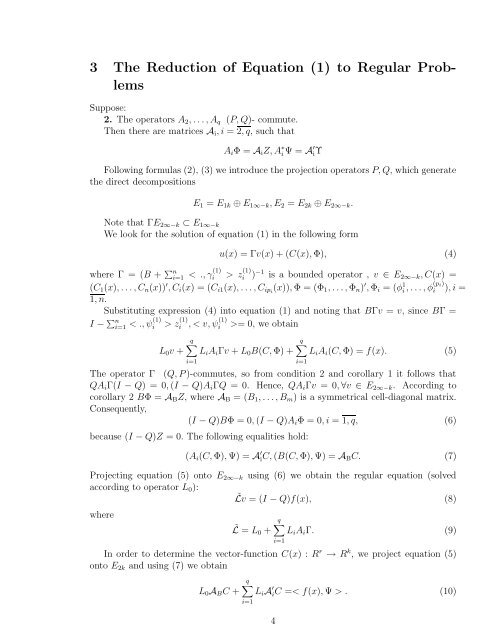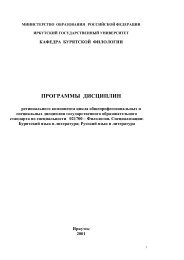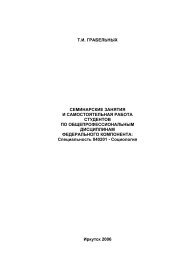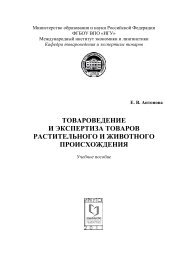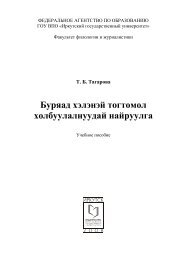Difference-differential Equations with Fredholm Operator in the Main ...
Difference-differential Equations with Fredholm Operator in the Main ...
Difference-differential Equations with Fredholm Operator in the Main ...
You also want an ePaper? Increase the reach of your titles
YUMPU automatically turns print PDFs into web optimized ePapers that Google loves.
3 The Reduction of Equation (1) to Regular Problems<br />
Suppose:<br />
2. The operators A 2 , . . . , A q (P, Q)- commute.<br />
Then <strong>the</strong>re are matrices A i , i = 2, q, such that<br />
A i Φ = A i Z, A ∗ i Ψ = A′ i Υ<br />
Follow<strong>in</strong>g formulas (2), (3) we <strong>in</strong>troduce <strong>the</strong> projection operators P, Q, which generate<br />
<strong>the</strong> direct decompositions<br />
E 1 = E 1k ⊕ E 1∞−k , E 2 = E 2k ⊕ E 2∞−k .<br />
Note that ΓE 2∞−k ⊂ E 1∞−k<br />
We look for <strong>the</strong> solution of equation (1) <strong>in</strong> <strong>the</strong> follow<strong>in</strong>g form<br />
u(x) = Γv(x) + (C(x), Φ), (4)<br />
where Γ = (B + ∑ n<br />
i=1 < ., γ (1)<br />
i > z (1)<br />
i ) −1 is a bounded operator , v ∈ E 2∞−k , C(x) =<br />
(C 1 (x), . . . , C n (x)) ′ , C i (x) = (C i1 (x), . . . , C ipi (x)), Φ = (Φ 1 , . . . , Φ n ) ′ , Φ i = (φ 1 i , . . . , φ (p i)<br />
i ), i =<br />
1, n.<br />
Substitut<strong>in</strong>g expression (4) <strong>in</strong>to equation (1) and not<strong>in</strong>g that BΓv = v, s<strong>in</strong>ce BΓ =<br />
I − ∑ n<br />
i=1 < ., ψ (1)<br />
i > z (1)<br />
i , < v, ψ (1)<br />
i >= 0, we obta<strong>in</strong><br />
q∑<br />
q∑<br />
L 0 v + L i A i Γv + L 0 B(C, Φ) + L i A i (C, Φ) = f(x). (5)<br />
i=1<br />
i=1<br />
The operator Γ (Q, P )-commutes, so from condition 2 and corollary 1 it follows that<br />
QA i Γ(I − Q) = 0, (I − Q)A i ΓQ = 0. Hence, QA i Γv = 0, ∀v ∈ E 2∞−k . Accord<strong>in</strong>g to<br />
corollary 2 BΦ = A B Z, where A B = (B 1 , . . . , B m ) is a symmetrical cell-diagonal matrix.<br />
Consequently,<br />
(I − Q)BΦ = 0, (I − Q)A i Φ = 0, i = 1, q, (6)<br />
because (I − Q)Z = 0. The follow<strong>in</strong>g equalities hold:<br />
(A i (C, Φ), Ψ) = A ′ iC, (B(C, Φ), Ψ) = A B C. (7)<br />
Project<strong>in</strong>g equation (5) onto E 2∞−k us<strong>in</strong>g (6) we obta<strong>in</strong> <strong>the</strong> regular equation (solved<br />
accord<strong>in</strong>g to operator L 0 ):<br />
˜Lv = (I − Q)f(x), (8)<br />
where<br />
q∑<br />
˜L = L 0 + L i A i Γ. (9)<br />
i=1<br />
In order to determ<strong>in</strong>e <strong>the</strong> vector-function C(x) : R r → R k , we project equation (5)<br />
onto E 2k and us<strong>in</strong>g (7) we obta<strong>in</strong><br />
q∑<br />
L 0 A B C + L i A ′ iC =< f(x), Ψ > . (10)<br />
i=1<br />
4


